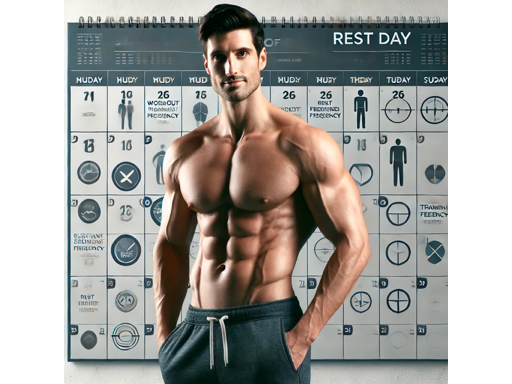The Pursuit of the Best Muscle Building Frequency for Men Over 40
When you hit your forties, the rules of the game start to change. What used to work in your twenties and thirties doesn’t quite cut it anymore. If you’re anything like me, you’ve probably spent countless hours searching, testing, and rethinking your approach. Spending too much time discovering the best muscle building frequency for men over 40 can take you away from what matters the most!
So, what’s the purpose of this guide, and what can you expect? This isn’t just another cookie-cutter article with a one-size-fits-all solution. We’re diving deep into the science and practicalities of building muscle in your forties and beyond. Please bear with there article length, I like top be thorough and ensure that you’ve gained knowledge in exchange for your valuable time.
This guide is here to help you cut through the noise, giving you the research-backed insights and hard-won lessons to help you find a frequency that’s not only effective but sustainable. By the end, you’ll have a clearer understanding of the balance between frequency, volume, and intensity – and, more importantly, how to apply that knowledge to get the best results for you.
Let’s get started on this journey to discovering the most effective muscle building frequency for men over 40. This is a lengthy one! It has to be. Wisdom usually follows age, but not in all cases…. especially searching for the perfect training frequency, it doesn’t exist.
Key Takeaways: The Best Muscle Building Frequency for Men Over 40
- Muscle-building after 40 requires a tailored approach that considers age-related changes in recovery and joint health.
- Intensity often takes priority over frequency for men over 40, as heavier weights with fewer sets yield effective results without risking burnout.
- Studies show that training each muscle group twice per week is optimal, providing a balance of stimulation and recovery for sustained growth.
- Research suggests 10-20 working sets per week per muscle group are ideal, with fewer sets if training to failure and more if leaving reps in reserve, using a moderate rep range (8-12) to reduce joint strain.
- Frequency alone doesn’t guarantee results; a mix of quality training, proper recovery, and manageable intensity is essential.
- Full-body workouts and split routines both have benefits; the choice should align with individual goals and lifestyle.
- Progressive overload—consistently increasing weight, reps, or intensity—is key to ongoing growth, especially when combined with the right training frequency.
- Experimenting with different frequencies and adjusting based on personal response helps find the best routine, as there is no universal approach for everyone.
- Nutrition, sleep, and stress management play crucial roles in muscle recovery and growth; a high-protein diet, adequate rest, and controlled stress levels support long-term gains.
- Supplements like creatine and protein powder can help fill gaps in the diet, particularly for supporting muscle repair and energy.
Why Training Frequency Matters in Muscle Building

Defining Frequency, Volume, and Intensity
Before diving into the best muscle-building frequency for men over 40, we need to define some core principles. Frequency, volume, and intensity – these aren’t just buzzwords in fitness circles. They’re the foundation of effective muscle-building routines, especially for those of us who no longer recover as quickly as we once did. Let’s break them down.
- Frequency is how often you train a muscle group in a set period, typically a week. For example, training your chest on Monday and Thursday gives it a frequency of twice per week.
- Volume refers to the total amount of work in each workout, generally calculated by the sets and reps performed. A classic example might be three sets of 10 reps for each exercise targeting a specific muscle group. Volume is crucial as it dictates the workload your muscles face – too little won’t stimulate growth, and too much risks overtraining.
- Intensity is the level of effort you bring to each rep and set. Often, it’s associated with the weight you’re lifting relative to your one-rep max (the heaviest weight you can lift for a single repetition). But intensity goes beyond weight; it’s about your focus and drive in each session. It’s the difference between going through the motions and truly pushing yourself.
Age-Related Adaptations in Muscle Growth

Testosterone levels gradually decline as men age, beginning around age 30 at an average rate of about 1% per year. This decline can impact muscle growth and recovery, making it essential to adapt training and recovery strategies.”
— Dr. Michael A. Werner, Andrologist, specialising in male hormone health.
As we hit our forties and beyond, our bodies go through a series of changes that impact how we build and maintain muscle. Understanding these physiological adaptations is key to designing a training programme that truly works.
Firstly, hormonal shifts play a major role. Testosterone, the hormone closely linked to muscle growth, naturally declines with age. While this drop isn’t dramatic, it does mean our bodies don’t respond to resistance training as effectively as they used to. Lower testosterone slows down muscle repair and recovery, making the balance between training frequency and intensity even more essential.
Next is recovery rate. In our twenties, muscles seemed to bounce back almost overnight (although the muscle and strength building mistakes I made in my 20’s were staggering). Now, it’s a different story. As we age, muscle recovery slows due to changes in protein synthesis – the process where the body repairs muscle fibres. This slower recovery means hitting the same muscle group multiple times a week can lead to fatigue rather than growth if we don’t allow enough rest.
Lastly, joint health and overall structural resilience become increasingly important. Years of activity can wear down cartilage and connective tissue, and high-impact, high-frequency workouts can add unnecessary strain or even cause injury. Many men over 40 find they need to choose exercises more mindfully, focusing on movements that strengthen without stressing the joints.
These changes don’t mean muscle-building is out of reach, far from it. They simply require a strategic approach – one that respects the demands of an ageing body while optimising training frequency, volume, and intensity for long-term success. don’t think building muscle is as complicated as you’ve been lead to believe.
Frequency vs. Intensity: What Drives Muscle Growth for Men Over 40?
For older adults, training intensity has shown a more direct impact on muscle hypertrophy than frequency alone. By focusing on lifting close to maximum capacity, older lifters can achieve better outcomes with fewer sessions.”
— Dr. Brad Schoenfeld, Ph.D., Professor of Exercise Science, CUNY Lehman College.
Now, here’s the core question: what matters more, frequency or intensity? For men over 40, both play a role. But intensity? It often steals the show. Work with intensity, keep good form, and you’ll need fewer sets to get the job done. Trust me, no one our age complains about not spending enough time at the gym. (My wife barely tolerates the time I already spend there – joking, she’s a good one!)
Studies back this up. Research shows that focusing on intensity – lifting heavier weights with real effort – delivers better gains than simply ramping up frequency. One study in the Journal of Strength and Conditioning Research found that people who pushed their muscles with heavier loads gained more strength and muscle than those training with lighter weights more often.
But don’t write off frequency. It’s essential for managing volume across the week. But ramping up frequency without intensity? That’s just spinning your wheels. You’ll burn energy, but you won’t see results.
In the end, both frequency and intensity matter. But it’s the effort you bring and pushing for progress that make the real difference.
the Latest Research On the Best Muscle Building Frequency for Men Over 40

Current Studies on Optimal Frequency for Muscle Growth
Let’s cut straight to the science. What do the latest studies say about the best muscle building frequency for men over 40? Research points to a clear trend: frequency matters, but it’s all about striking the right balance.
One meta-analysis published in the Journal of Sports Sciences analysed dozens of studies on training frequency. It found that training each muscle group twice a week often led to better muscle growth than just once a week. This was particularly true for older adults. Why? Because twice-weekly training provides enough stimulus for muscle growth without overwhelming the body’s recovery systems. In other words, twice a week hits the sweet spot between growth and recovery.
Another study from the Journal of Strength and Conditioning Research supports this. Researchers observed that lifters training a muscle group twice per week saw significant increases in muscle size and strength, more so than those training just once a week. The findings were especially relevant for men over 40, as the moderate frequency allowed for enough recovery time, a crucial factor for those of us in this age bracket.
Frequency as a Tool to Distribute Volume
Now, let’s talk volume. Volume refers to the total sets and reps you perform each week. For men over 40, volume is crucial – but managing it requires strategy. Frequency becomes the tool to spread this volume across the week, keeping recovery in check.
Frequency isn’t just about training more often. It’s about being smart with volume. Research shows that spreading volume through frequency lets older lifters push hard without risking burnout. It’s how you keep progressing without putting yourself on the injury list.
Just look at frequency as a method of getting your volume in! Believe it or not, frequency is quite low in the pecking order for muscle growth. It matters, but providing you’re progressing each time you visit the gym and your nutrition/rest is on point- you’ll gain muscle.
Evidence-Based Frequency Recommendations for Men Over 40

Research supports that twice-weekly training for each muscle group is generally optimal for older adults, balancing adequate recovery with sufficient stimulus for growth.”
— Journal of Strength and Conditioning Research (2020)
So, what’s the takeaway? What’s the best muscle building frequency for men over 40 according to science?
Research suggests 10–20 working sets per muscle group per week is the sweet spot for growth. But here’s the catch – it depends on how close you’re pushing to failure. If you’re grinding out each set with real intensity, right to the edge of technical failure, stick closer to 10 sets. Leaving a few reps in the tank? Then you can push up to 20. A standard hypertrophy rep range of 6-12 controlled reps is ideal. I generally favour around 8-12 to ensure less joint stress and complete volume requirements are met (2 seconds up and 2 seconds down cadence).
There’s a balance here: the harder you push each set, the fewer you need. Back off the intensity slightly, and you can afford more volume. It’s all about finding that middle ground where effort and recovery meet.
For most men over 40, training each muscle group twice a week (or a little less) is ideal. This frequency allows you to hit the volume sweet spot without taxing your recovery. Larger muscle groups like legs, chest, and back usually benefit from this twice-weekly approach. Smaller muscle groups – think biceps and triceps – might need less frequency depending on how they’re integrated into other workouts.
If you’re new to lifting or coming back after a break, you might want to start with once a week per muscle group, then build up. As your body adapts, you can shift to twice-weekly sessions, maintaining enough rest between workouts. Listen to your body – it’ll tell you if you’re pushing too hard.
In short, research backs a moderate, twice-weekly frequency for men over 40 aiming for muscle growth. It’s enough to stimulate gains, spread volume smartly, and keep your recovery on point. Don’t worry, I will take you through a good personal working example below.
Meta-analyses indicate that between 10 and 20 weekly sets per muscle group is sufficient for hypertrophy, particularly for intermediate to advanced lifters. Higher volumes may only be beneficial if managed with ample recovery.”
— Dr. James Krieger, Exercise Physiologist and Researcher in resistance training.
Common Myths and Misconceptions About the Best Muscle Building Frequency for Men Over 40
Myth 1: Higher Frequency Always Equals Better Results
One of the biggest myths out there is that training more frequently will automatically lead to better results. Many believe that if a little is good, then more must be better. But when it comes to muscle growth, especially for men over 40, this idea doesn’t hold up.
Research and experience show that increasing frequency alone doesn’t guarantee muscle gains. Without enough intensity and recovery, training too often can lead to fatigue, overtraining, and even injury. A study in the Journal of Strength and Conditioning Research highlights that muscles need time to repair and grow after intense sessions. Pushing the same muscle group multiple times a week without allowing for proper recovery can actually stall progress. It’s not just about how often you hit the gym; it’s about the quality of each session.
For men over 40, focusing on moderate frequency with higher intensity is far more effective. Train hard, give your muscles time to recover, and you’ll see better results than simply increasing frequency for the sake of it.
Myth 2: Full-Body Workouts Aren’t Effective for Older Men
There’s a misconception that full-body workouts aren’t as effective for older men. Some think you need to isolate each muscle on different days to see real gains. But full-body routines can be powerful, especially when structured correctly.
A well-designed full-body workout hits the major muscle groups without overloading any single area. Research supports this approach, showing that full-body routines can build strength and muscle size effectively, even with lower overall frequency. The key is balance – working each muscle enough to stimulate growth but allowing ample recovery time.
Myth 3: You Need High Volume to Build Muscle as You Age
The “more is better” mindset also applies to volume, with many assuming that piling on sets and reps is the golden ticket to muscle growth. But high volume alone isn’t a magic bullet, especially as we get older.
Volume is important, but it’s not the only factor. For men over 40, too much volume can lead to exhaustion, joint strain, and burnout. Instead, focusing on moderate volume paired with high intensity and smart frequency yields better, more sustainable gains. Studies suggest that for most lifters, including older adults, 10–20 hard sets per muscle group per week is ideal. Going beyond that can risk overtraining and hinder progress.
Quality beats quantity. Rather than obsessing over volume, focus on hitting each muscle with a reasonable number of sets and pushing for intensity. This approach supports muscle growth while preserving your energy and keeping your joints in good shape.
Myth 4: You’ll Find The Perfect Workout Routine
No such thing exists I’m afraid. Get hung up on on looking for it and you’ll get nowhere fast.
Think about this…. there’s literally thousands of training plans that people from all walks of life perform. These training plans can all be effective, depending if you’re bringing the intensity, volume, nutrition, progression and adequate rest to the table! the best training program in the world can be terrible if you’re not committed! There’s no silver bullet to this muscle building game.
Designing an Effective Muscle Building Routine for Men Over 40
Choosing Between Full-Body Workouts and Split Routines
Full-body workouts allow for more frequent activation of each muscle group, which can be effective for hypertrophy, especially in older adults who may not tolerate high-volume split routines.”
— Dr. Chris Beardsley, Sports Scientist, Researcher in strength training adaptations.
When designing the best muscle building frequency for men over 40, the choice between full-body workouts and split routines is crucial. Both approaches have their place, but each offers unique advantages depending on your goals and schedule.
- Full-Body Workouts: Full-body routines target all major muscle groups in a single session. They’re efficient, making them ideal for men who can only train two to three times per week. With this approach, you hit each muscle group with enough frequency to stimulate growth without overloading any single area. Full-body workouts also maximise recovery time between sessions, which is essential for those of us who may not bounce back as quickly as we once did.
- Split Routines: Split routines, on the other hand, divide muscle groups across different days. Common splits include upper/lower body or push/pull/legs. This approach allows you to focus more on each muscle group in a session, usually with higher volume. For those training four or more days a week, split routines offer a way to spread out volume without risking fatigue in any one area. However, split routines require more frequent gym sessions, which may not suit everyone’s lifestyle.
In short, if you’re looking for efficiency and have limited time, a full-body workout is likely your best bet. If you prefer targeting specific muscles with more focus and can commit to more days in the gym, a split routine could be the way to go.
Sample Training Plans for Different Frequencies

Now, let’s look at some sample training plans. Whether you’re aiming for twice, three, or four times a week, there’s a plan to suit every schedule and fitness level. Here are some examples to get you started. You’ll find many articles within the muscle building section of the website. They go into more detail regarding exercises and techniques, the below is a loose example to show you how you can easily satisfy the volume criteria with a few sample workouts.
2-Day Full-Body Plan:
When really pushed for time, you absolutely can gain muscle on a 2 day a week plan. Providing you’re ensuring your selection of exercises are good and the volume/intensity/outside of gym criteria is satisfied you’ll grow muscle.
- Day 1: Squats, Incline Dumbbell press, Lat Pulldown (or pull ups), Shoulder Press, Dumbbell Rows, Core Work.
- Day 2: Deadlifts, Lunges, Incline Barbell Press, Pull-Ups, Bicep Curls, lateral raises, Tricep Extensions.
Perform 5 sets of 8-12 reps per exercise and you’ll more than hit the 10-20 set sweet spot for growth (especially factoring in overlapping work – biceps getting worked with pull-ups, shoulders with chest presses etc)
3-Day Full-Body Plan:
- Day 1: Squats, Bench Press, Rows, Core.
- Day 2: Lunges, Overhead Press, Pull-Ups, Core.
- Day 3: Deadlifts, Dumbbell Press, Lat Pulldown, Core.
I won’t go into as much depth here as you should get the point by now. Spread your volume out over these sessions and pick appropriate exercises.
4-Day Upper/Lower Split:
- Day 1 (Upper): Bench Press, Rows, Shoulder Press, Bicep Curls, Tricep Extensions.
- Day 2 (Lower): Squats, Lunges, Calf Raises, Core Work.
- Day 3 (Upper): Incline Press, Lat Pulldown, Dumbbell Rows, Face Pulls.
- Day 4 (Lower): Deadlifts, Leg Press, Hamstring Curls, Core Work.
The 4-day upper/lower split allows for focused sessions on each half of the body, making it ideal for those with a bit more time and recovery capacity.
Each of these plans balances frequency and volume while ensuring enough recovery time, especially important for men over 40.
What About A Muscle Group Once Per Week?
These can work and a sample one muscle group a week plan can look like below (although I don’t favour them for reasons listed below)
4 sets of 8-12 reps and you’ll see the volume criteria more than met.
- Day 1 (Chest and Triceps): Bench Press, Incline Dumbbell Press, Cable crossovers, Tricep Rope Extension, Tricep Pushdowns
- Day 2 (Legs and Core): Squats/leg press, Lunges, Hamstring Curls, Leg Extensions, Calf Raises, core work
- Day 3 (Back and Biceps ): Trap Bar Deadlift, Lat Pull-down, Dumbbell Row, Barbell Curl, Hammer Curls
- Day 4 (Shoulders): Dumbbell Shoulder Press, Lateral Raises, Machine Shoulder Press, Rear Lateral Raises
Once a week training (for me at least) has two major drawbacks.
- My schedule is erratic, if i miss a session, it’s impossible to play catch up.
- One muscle group a week means that for every session you need to bring the intensity and force the muscle to grow. As a busy dad, I try my best, but if I fail, I’ve wasted one of the 52 sessions a year.
This isn’t to advise it won’t work for you, but I prefer less training days per week and more frequency opportunity to work the muscle hard.
Integrating Progressive Overload with Frequency
Recovery is the unsung hero of strength training, especially for older adults. Without enough rest, even the most optimally structured programme will fail to yield results.”
— Dr. Stuart Phillips, Ph.D., Professor of Kinesiology, McMaster University.
Frequency alone won’t drive results – progressive overload is key. Progressive overload means consistently challenging your muscles by increasing weight, reps, or intensity over time. For men over 40, combining progressive overload with an appropriate frequency is essential to stimulate growth without risking burnout.
Here’s how to do it:
1. Increase Weight Gradually: Start with weights you can manage with good form. Once a set feels easy, bump up the weight slightly. Small increases, over time, make a huge difference in muscle growth.
2. Add Reps or Sets: If adding weight feels too taxing, increase the reps or sets instead. For example, if you’re hitting 10 reps comfortably, push to 12 reps next session or add an extra set.
3. Adjust Frequency Based on Recovery: If recovery slows down, adjust the frequency. Focus on high-quality, intense sessions and avoid adding more training days if your body needs rest. Quality beats quantity every time.
Incorporating progressive overload ensures that each session builds on the last. You’re not just going through the motions – you’re pushing yourself. This combination of frequency and progressive overload is what drives sustainable muscle growth, particularly for men over 40 looking for a routine they can stick with.
As I mention frequently throughout the article, you’ll find a plethora of muscle building articles within the website.
Progressive overload is the cornerstone of muscle growth. Increasing the resistance, reps, or total work performed over time ensures continued adaptation and hypertrophy.”
— Dr. Mike Israetel, Sports Physiologist and Co-Founder of Renaissance Periodisation.
My Journey to Discovering the Best Muscle Building Frequency

Experimenting with Different Frequencies Over the Years
Let me take you back a bit. I’ve been down the road of trying almost every training frequency you can imagine. Like many, I started out thinking that more was better. I figured, if training once a week is good, then hitting the same muscles multiple times would be great, right? Well, it wasn’t quite that simple.
I went through phases. There was the high-frequency phase, where I’d train the same muscle groups daily. Yes, daily. At first, I thought I was onto something. But after a few weeks, I started feeling drained. My muscles were fatigued, but worse, so was my enthusiasm. The constant pounding left little room for recovery, and I quickly realised I was spinning my wheels without seeing real progress. High frequency only got me to the point of overtraining, not growth. I thoroughly document this journey within my muscle building mistakes article.
Next, I tried the once-a-week approach. I figured that if daily wasn’t working, maybe I needed to pull back. Training each muscle group only once per week seemed like the answer. And for a while, it felt great. My body got ample time to recover, and I was hitting each session fresh. But as the weeks went by, I noticed something – my gains were minimal. The long gap between working the same muscles left too much time for them to adapt without enough consistent stimulus. Once-a-week training kept me from overtraining, but it also limited my progress.
Then came the split routines. I experimented with various combinations – push/pull, upper/lower, even the classic bro split. Splits gave me the chance to focus intensely on a few muscles each session. But with each variation, I learned that too much volume in a single session wasn’t the answer either. By the end of each workout, I was exhausted, and sometimes my form suffered.
Each phase taught me something valuable. High frequency isn’t sustainable. Low frequency doesn’t offer enough stimulus. And too much volume in a single session leads to fatigue, not gains. I realised that the best muscle building frequency for men over 40 had to strike a balance.
The Optimal Frequency I’ve Settled On and Why
So, where did all this experimenting lead me? These days, I’ve settled on training each muscle group around once every 4-5 days on an ABA split. This frequency gives me the right mix of stimulus and recovery/balance with my personal life and erratic schedule. It’s frequent enough to keep the muscles engaged and prevent them from fully recovering (which, counterintuitively, is good for growth), but it’s not so frequent that I burn out.
This frequency has given me consistent progress without the rollercoaster of fatigue and frustration. I’m able to train with enough intensity to push for growth, knowing I’ll get a few days to recover before hitting the same muscle group again.
This approach works for me now, but it’s always a matter of listening to the body. There’s no one-size-fits-all in muscle building, especially as we get older. Needs change, recovery rates fluctuate, and the body doesn’t respond the same way year after year. My advice? Start with a frequency that feels challenging but sustainable. Give it a few weeks, see how your body responds, and adjust as needed. Your optimal frequency isn’t fixed – it evolves as you do. Don’t program hop. As we’ve covered, science dictates frequency is simply a way to section your volume off – nothing more.
My Sample Workout Routine And Why It Hits The Sweet Spot
The workout is perfectly balanced (for me) frequency, volume and in exercise variety. It’s also flexible. If I’m particularly busy one week I will get workout A and B done once throughout the week and still progress.
3 times a week in an A-B-A format (all 6-10 range of reps unless stipulated differently)
Workout A
- Incline dumbbell or barbell chest press 3 sets
- Parallel bar dips (weighted if possible) 3 sets
- Flyes or cable crossovers 3 sets
- Barbell/machine shoulder press 3 sets
- Lateral raises 3 sets (12-15 reps for these)
- Tricep pushdown 3 sets
- Hanging leg raises – 3 sets to failure
Workout B
- Pull-ups (graduating to weighted) 3 sets
- Dumbbell/machine row 3 sets
- Barbell bicep curl 3 sets
- Squat or leg press 3 sets
- Hamstring curls 3 sets
- Calf raises 3 sets (12-15 for these)
- Weighted cable crunch (12-15 for these)
This has generally been my staple for the last 10 years and I’m stronger and have more muscle now than I DID 10 YEARS AGO! And I used to do double the volume (it was junk volume) I track my workouts, try to eat well and bring the intensity with good form.
Supporting Muscle Growth with Nutrition, Recovery, and Lifestyle

Protein and Macronutrient Needs for Muscle Growth
Older adults aiming to build muscle should consume around 1.6 to 2.2 grams of protein per kilogram of body weight daily, as protein is crucial for muscle repair and hypertrophy.”
— Dr. Robert Wolfe, Ph.D., Expert in protein metabolism, University of Arkansas.
Building muscle isn’t just about what you do in the gym – it’s also about what you put on your plate. For men over 40, protein is king. Protein supports muscle repair and growth, helping you recover faster and hit each workout at full strength. Aim for around 1.6–2.2 grams of protein per kilogram of body weight each day. This range is optimal for muscle gain, according to numerous studies. Lean sources like chicken, fish, eggs, beef and Greek yogurt are excellent choices, along with high-quality protein powders if you need a boost.
Alongside protein, balance your macronutrients – carbs and fats. Carbs fuel your workouts and aid recovery by replenishing glycogen stores, while healthy fats support hormone production, including testosterone, which naturally declines with age. A well-rounded diet gives your body the fuel it needs to train hard, recover well, and keep muscle-building consistent. You can head over to my fat loss section if you want to learn the correct way to lose fat and stay sane!
Importance of Sleep, Stress Management, and Recovery
Sleep and stress management are often overlooked, yet they’re crucial for muscle growth. When you sleep, your body repairs and builds muscle tissue. Aim for 7–9 hours per night to allow your muscles to recover and your nervous system to recharge. Lack of sleep slows recovery, reduces energy levels, and can even impact hormone levels – none of which help with muscle gain.
Stress management is just as important. High stress increases cortisol, a hormone that can hinder muscle growth and slow recovery. Incorporate stress-relieving practices like meditation, deep breathing, or even a simple walk outdoors. Make relaxation part of your muscle-building routine. Remember, recovery isn’t just about resting the muscles; it’s about creating a lifestyle that supports consistent, long-term growth.
Supplement Recommendations for Men Over 40
Supplements aren’t magic, but they can help fill the gaps in your diet. For men over 40, only one supplement has stood the test of time regarding muscle building – the rest are quite frankly bull@hit.
- Creatine: Creatine monohydrate is one of the most researched supplements and has proven to support strength and muscle gains. It helps your muscles produce more energy, allowing you to train harder. Studies show it’s safe and effective, especially for older adults.
- Protein Powder: While not essential, a quality protein powder is a convenient way to meet daily protein needs, especially after workouts when your muscles are primed for repair.
FAQs the Best Muscle Building Frequency for Men Over 40
1. What is the best training frequency for muscle growth after 40?
Research suggests that training each muscle group twice per week is ideal for men over 40. This frequency balances muscle stimulation with adequate recovery, allowing for optimal growth without overtraining.
2. Why does recovery become more important with age?
As men age, recovery slows due to a natural decline in testosterone and changes in protein synthesis. This means muscles need more time to repair and rebuild after workouts, making adequate rest crucial for preventing fatigue and injuries.
3. What is the recommended weekly training volume for muscle growth?
Studies suggest that 10–20 working sets per muscle group per week is optimal for hypertrophy. If you’re training with high intensity (close to failure), aim for the lower end of the range. If leaving a few reps in reserve, you can increase volume toward the higher end.
4. Are full-body workouts or split routines better for older men?
Both approaches can work, depending on your schedule and goals. Full-body workouts are efficient for men training 2–3 times a week, while split routines (e.g., upper/lower or push/pull/legs) work well for those training 4+ days weekly. Choose based on what fits your recovery and lifestyle.
5. Does training frequency matter more than intensity?
For men over 40, intensity often matters more than frequency. Lifting with sufficient weight and effort (close to failure) is more effective for muscle growth than simply increasing how often you train. However, frequency is important for managing volume and avoiding burnout.
6. Can I still build muscle with just two training days a week?
Yes! By focusing on compound exercises and hitting all major muscle groups in each session, you can still build muscle with just two days a week. Ensure you bring intensity to every workout and aim for 10+ working sets per muscle group weekly.
7. What are the common mistakes men over 40 make when designing a workout routine?
- Overtraining: Trying to train too often without enough recovery.
- Ignoring joint health: Performing high-impact exercises without considering wear and tear.
- Focusing solely on volume: Neglecting intensity and progressive overload in favour of more sets and reps.
- Skipping recovery strategies: Overlooking the importance of sleep, stress management, and proper nutrition.
8. How do I integrate progressive overload into my routine?
Progressive overload involves gradually increasing the challenge to your muscles over time. This can be done by:
- Adding more weight to your lifts.
- Increasing the number of reps or sets.
- Improving your exercise form or range of motion.
- Reducing rest times between sets.
Balance this with your recovery capacity to avoid overtraining.
Conclusion
In conclusion, finding the best muscle building frequency for men over 40 isn’t about rigid rules or one-size-fits-all solutions. It’s about discovering a rhythm that balances frequency, intensity, and recovery to fit your lifestyle and goals. As we age, our bodies demand a smarter approach to training—one that respects the need for recovery, focuses on quality over quantity, and avoids unnecessary strain on the joints.
The key lies in combining moderate frequency with the right intensity, aiming for 10-20 quality sets per week, and listening to your body’s feedback.
Muscle growth in your forties and beyond is absolutely possible, but it requires commitment, patience, and a bit of experimentation to find what works best for you. Stick with it, track your progress, and remember that sustainable gains come from a holistic approach that includes proper nutrition, rest, and mental well-being.
For more insights, tips, and strategies on muscle building, fitness, and health for men over 40, be sure to explore the rest of my posts across various categories. Dive into topics like workout strategies, nutrition hacks, and everything else you need to stay strong and fit beyond your prime.
Chat soon,
Matt


7 thoughts on “The best Muscle building Frequency For Men Over 40”
Comments are closed.